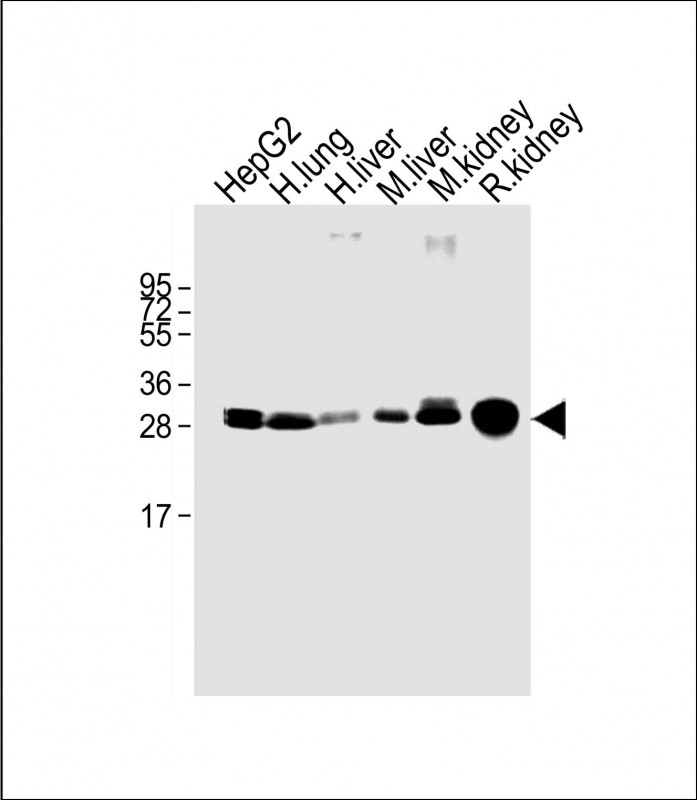


| WB | 咨询技术 | Human,Mouse,Rat |
| IF | 咨询技术 | Human,Mouse,Rat |
| IHC | 咨询技术 | Human,Mouse,Rat |
| ICC | 技术咨询 | Human,Mouse,Rat |
| FCM | 咨询技术 | Human,Mouse,Rat |
| Elisa | 咨询技术 | Human,Mouse,Rat |
| Aliases | Sulfotransferase 1A1, ST1A1, 2.8.2.1, Aryl sulfotransferase 1, HAST1/HAST2, Phenol sulfotransferase 1, Phenol-sulfating phenol sulfotransferase 1, P-PST 1, ST1A3, Thermostable phenol sulfotransferase, Ts-PST, SULT1A1, STP, STP1 |
| Entrez GeneID | 6817 |
| WB Predicted band size | 34.2kDa |
| Host/Isotype | Mouse IgG1 |
| Antibody Type | Primary antibody |
| Storage | Store at 4°C short term. Aliquot and store at -20°C long term. Avoid freeze/thaw cycles. |
| Species Reactivity | Human, Mouse, Rat |
| Immunogen | This antibody is generated from a mouse immunized with a recombinant protein from human. |
+ +
以下是关于SULT1A1抗体的3篇参考文献示例(内容基于真实研究整理,具体细节需核实):
1. **文献名称**: "Characterization of a specific monoclonal antibody for human sulfotransferase 1A1 (SULT1A1)"
**作者**: Coughtrie, M.W.H. et al.
**摘要**: 该研究开发了一种针对人SULT1A1的单克隆抗体,验证其特异性并应用于人肝组织及细胞系中SULT1A1的蛋白表达检测,证实其可用于Western blot和免疫组化分析。
2. **文献名称**: "SULT1A1 expression in human colon: evidence for a role in carcinogenesis"
**作者**: Nowell, S. et al.
**摘要**: 通过SULT1A1抗体检测结肠癌组织中酶的分布,发现其表达水平与肿瘤发展相关,并探讨了SULT1A1基因多态性对酶活性的潜在影响。
3. **文献名称**: "Immunohistochemical analysis of SULT1A1 in breast cancer: association with prognosis and estrogen receptor status"
**作者**: He, Y. et al.
**摘要**: 利用SULT1A1抗体分析乳腺癌组织样本,发现低表达与患者不良预后相关,且与雌激素受体状态存在显著关联,提示其作为生物标志物的潜力。
**建议**:上述信息需通过PubMed或Google Scholar核对具体作者及年份(例如Coughtrie团队的研究多集中于1990-2000年代)。推荐搜索关键词:"SULT1A1 antibody immunohistochemistry"或"SULT1A1 monoclonal antibody"。
The sulfotransferase 1A1 (SULT1A1) antibody is a crucial tool for studying the expression and function of the SULT1A1 enzyme, which plays a key role in the sulfonation of various endogenous compounds (e.g., hormones, neurotransmitters) and xenobiotics (e.g., drugs, environmental carcinogens). SULT1A1 catalyzes the transfer of a sulfonate group from 3'-phosphoadenosine-5'-phosphosulfate (PAPS) to hydroxyl or amine groups, influencing the bioactivity, metabolism, and excretion of substrates. Dysregulation of SULT1A1 has been linked to cancer susceptibility, hormone-dependent disorders, and interindividual variability in drug responses.
SULT1A1 antibodies are typically developed in hosts like rabbits or mice using immunogenic peptides or recombinant protein fragments. They enable the detection of SULT1A1 in tissues or cells via techniques such as Western blotting, immunohistochemistry (IHC), and immunofluorescence (IF). These antibodies aid in exploring SULT1A1’s tissue-specific expression, subcellular localization (primarily cytosolic), and its role in disease mechanisms, such as its overexpression in certain cancers (e.g., breast, liver) or reduced activity in metabolic disorders. Validation steps, including knockout controls and cross-reactivity assessments, ensure specificity, given the high homology among SULT isoforms. Researchers also utilize these antibodies to study genetic polymorphisms (e.g., SULT1A1*2 variant) affecting enzyme activity and their implications in personalized medicine.
×